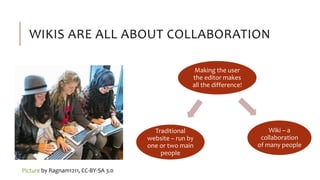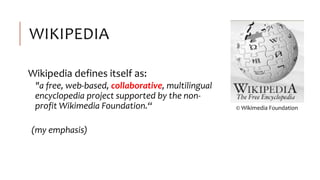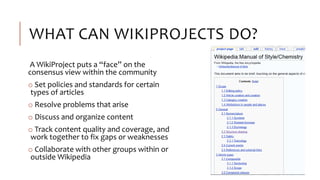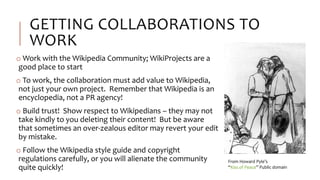Chemistry collaborations on wikipedia
- 2. OVERVIEW o Introduction o WikiProjects within Wikipedia o Working with ChemSpider o CAS and CommonChemistry o IUPAC definitions within Wikipedia o Further collaborations o Getting collaborations to work o Conclusion
- 3. WIKIS ARE ALL ABOUT COLLABORATION Making the user the editor makes all the difference! Traditional website ©C run by one or two main people Wiki ©C a collaboration of many people Picture by Ragnam1211, CC-BY-SA 3.0
- 4. WIKIPEDIA Wikipedia defines itself as: "a free, web-based, collaborative, multilingual encyclopedia project supported by the non- profit Wikimedia Foundation.Ī░ (my emphasis) ? Wikimedia Foundation
- 7. COVERS GENERAL CHEMISTRY CONTENT Reactions & processes, chemistry concepts, equipment, chemistsĪ» biographies, history, etc.
- 8. WIKIPROJECT CHEMICALS Collaborates on writing quality articles and standards on chemical substances: ?developing data boxes for articles ?chemical naming, structure drawing ?article assessment Data validation on chemical properties Collaborated with ChemSpider, CAS, etc.
- 9. WIKIPROJECT ELEMENTS Focused on the chemical elements, periodic table, etc. Other WikiProjects deal with ? Pharmacology ? Molecular & Cellular Biology
- 10. WHAT CAN WIKIPROJECTS DO? A WikiProject puts a Ī░faceĪ▒ on the consensus view within the community o Set policies and standards for certain types of articles o Resolve problems that arise o Discuss and organize content o Track content quality and coverage, and work together to fix gaps or weaknesses o Collaborate with other groups within or outside Wikipedia
- 11. COLLABORATION WITH CHEMSPIDER o After Antony Williams at ChemSpider began curating Wikipedia content in December 2007 , the Chemicals WikiProject began a formal collaboration. o This allowed cross-checks to be made between ChemSpider and Wikipedia content o This, and contact with Peter Murray- Rust, led to a redesign of the ChemBox to make it more machine-friendly o Informal contact continues today
- 12. COLLABORATION WITH CAS In 2008, spurred on by the curation effort started by Antony Williams, WP:Chemicals began to try a formal, systematic validation of ChemBox content, beginning with CAS Registry numbers. Initially things didnĪ»t go wellĪŁ
- 13. COLLABORATION WITH CAS ĪŁbut it had a happy ending! CAS agreed to share a file containing details on 8000 common chemicals. This allowed WP:Chemicals to validate immediately CAS numbers on around 3000 of the most common substances This collection was also posted by CAS for free public access as CAS Common Chemicals ©C allowing Wikipedia users to click through to a validated CAS No. in the ChemBox. CheMoBot checks if the number is correct.
- 14. WIKIDATA ©C TAKING VALIDATION TO THE NEXT LEVEL Wikidata is a sister project of Wikipedia that aims to collate data that rarely or never change, and put them into a database that can be shared across all Wikimedia Foundation projects. Not yet used on the English Wikipedia. PubChem has already begun to share data with the Wikidata chemists, and it appears that EBI and others are also collaborating.
- 15. IUPAC DEFINITIONS IUPAC has informally collaborated with the Wikipedia community since 2008, mainly to ensure correct IUPAC definitions are available. A more formal collaboration has been under way with the IUPAC Polymers Committee since 2012.
- 16. FURTHER COLLABORATIONS WP:Chemicals, through the work of Dr. Dirk Beetstra, was able to extend the validation to other fields, by working with other organizations such as the European Bioinformatics Institute (EBI) and KEGG. These fields are patrolled by a bot that watches for any changes to validated ChemBox fields. Other informal collaborations have helped in other ways, e.g., Bob Hanson (St. OlafĪ»s College) worked with Dirk Beetstra to provide 3D images for all Chemboxes.
- 17. GETTING COLLABORATIONS TO WORK o Work with the Wikipedia Community; WikiProjects are a good place to start o To work, the collaboration must add value to Wikipedia, not just your own project. Remember that Wikipedia is an encyclopedia, not a PR agency! o Build trust! Show respect to Wikipedians ©C they may not take kindly to you deleting their content! But be aware that sometimes an over-zealous editor may revert your edit by mistake. o Follow the Wikipedia style guide and copyright regulations carefully, or you will alienate the community quite quickly! From Howard PyleĪ»s Ī░Kiss of PeaceĪ▒ Public domain
- 18. CONCLUSION Collaboration has made Wikipedia a richer and more reliable source for chemical information At the same time, Wikipedia has provided a useful platform for the chemistry community to reach the working chemist and the Ī░man on the Clapham omnibusĪ▒. It is likely that Wikidata will become the focus for further collaborations and validation work Youngsters looking at Ī░Albert EinsteinĪ▒ on Wikipedia. Picture by Ziko-C, CC-BY-SA 3.0
- 19. ACKNOWLEDGEMENTS Thanks to Physchim62, Wimvandorst, Rifleman82, DMacks, Edgar181, Beetstra, Cacycle, Stone, ~K, ChemSpiderMan/ChemConnector and Smokefoot for their tireless contributions to Wikipedia chemistry articles and validation. Thanks to our many collaborators outside Wikipedia including Antony Williams, David Sharpe (RSC/ChemSpider), Janice Mears (CAS), Michael Hess & Annie Rumble (IUPAC Polymers), Evan Bolton (PubChem), Bob Hanson (St. OlafĪ»s College) and many others. Wim Van Dorst, a Dutch member of WP:Chem since March 2005.
- 20. COPYRIGHT INFORMATION All of my own content in this presentation is released under a Creative Commons BY-SA-3.0 license Copyright information for images is usually attributed on the slide itself Content from Wikipedia is reused via a Creative Commons BY- SA-3.0 license. For authors, please visit the original Wikipedia page and select the Ī░historyĪ▒ tab. Other pictures not attributed (e.g., Wikipedians at Wikimania) should only be my own personal pictures, also CC-BY-SA3.
- 21. ANY QUESTIONS? Thank you for your attention





















